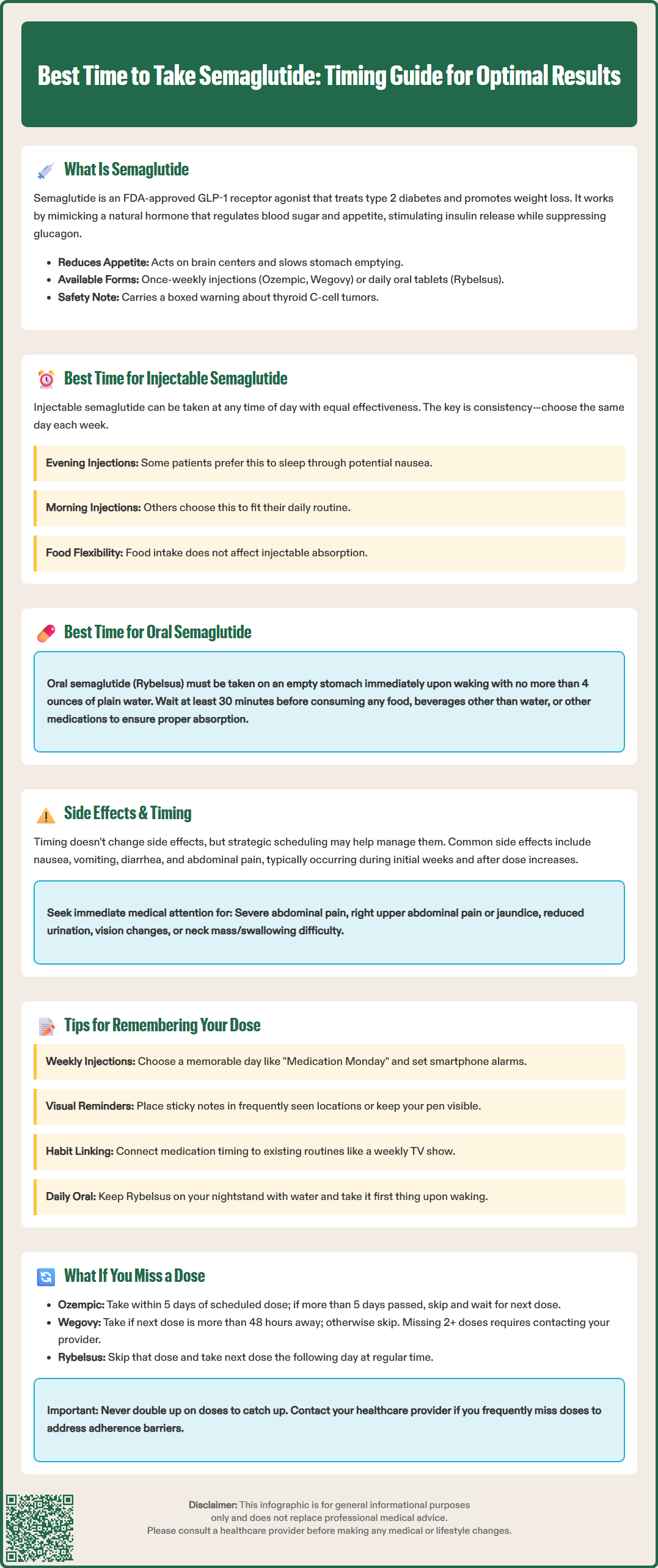LOSE WEIGHT WITH MEDICAL SUPPORT — BUILT FOR MEN
- Your personalised programme is built around medical care, not willpower.
- No generic diets. No guesswork.
- Just science-backed results and expert support.
Find out if you’re eligible

Semaglutide, available as Ozempic, Wegovy, and Rybelsus, is a GLP-1 receptor agonist approved for type 2 diabetes and weight management. The best time to take semaglutide depends on your formulation: injectable versions offer flexible timing on your chosen weekly day, while oral Rybelsus requires strict morning administration on an empty stomach. Understanding optimal timing ensures maximum absorption, therapeutic benefit, and adherence. This guide explains evidence-based recommendations for both formulations, strategies to manage side effects through timing, and what to do if you miss a dose.
Quick Answer: Injectable semaglutide can be taken at any time on your chosen weekly day, while oral Rybelsus must be taken first thing in the morning on an empty stomach, at least 30 minutes before food or other medications.
Semaglutide is a glucagon-like peptide-1 (GLP-1) receptor agonist approved by the FDA for the treatment of type 2 diabetes mellitus and chronic weight management. Available under brand names including Ozempic, Wegovy, and Rybelsus, this medication mimics the action of naturally occurring GLP-1, a hormone that plays a crucial role in glucose regulation and appetite control.
The mechanism of action involves several complementary pathways. Semaglutide binds to GLP-1 receptors on pancreatic beta cells, stimulating glucose-dependent insulin secretion. This means insulin is released primarily when blood glucose levels are elevated, reducing the risk of hypoglycemia compared to some other diabetes medications. Simultaneously, the medication suppresses glucagon secretion from pancreatic alpha cells, further contributing to improved glycemic control by reducing hepatic glucose production.
Beyond its effects on glucose metabolism, semaglutide acts on receptors in the brain's appetite centers, particularly in the hypothalamus and brainstem. This central action leads to reduced appetite and increased satiety, contributing to weight loss. The medication also slows gastric emptying, which prolongs the feeling of fullness after meals and helps moderate postprandial glucose excursions.
Semaglutide is available in two formulations: a once-weekly subcutaneous injection (Ozempic for diabetes, Wegovy for weight management) and a once-daily oral tablet (Rybelsus for diabetes). The extended half-life of approximately one week allows for convenient once-weekly dosing of the injectable formulations. Important safety considerations include an increased risk of hypoglycemia when used with insulin or sulfonylureas, and a boxed warning about thyroid C-cell tumors (contraindicated in patients with personal/family history of medullary thyroid carcinoma or Multiple Endocrine Neoplasia syndrome type 2). Semaglutide is not indicated for type 1 diabetes or diabetic ketoacidosis treatment.

The optimal timing for semaglutide administration differs significantly between the injectable and oral formulations, and following manufacturer guidelines is essential for achieving maximum therapeutic effect.
Injectable Semaglutide (Ozempic, Wegovy)
For the once-weekly subcutaneous injection, there is considerable flexibility regarding the time of day. According to FDA labeling, the injection can be administered in the morning, afternoon, or evening with consistent efficacy. The key consideration is consistency—selecting a specific day of the week and maintaining that schedule helps establish a routine and improves adherence.
Many patients prefer administering their weekly injection on the same day each week, often choosing a day when they have time to monitor for potential side effects. Some individuals find that injecting in the evening allows them to sleep through any initial nausea, while others prefer morning administration to align with their daily routine. The injection can be given with or without food, providing additional flexibility. If needed, you may change your weekly injection day, provided there are at least 48 hours between doses.
Oral Semaglutide (Rybelsus)
The oral formulation requires much more specific timing to ensure adequate absorption. Rybelsus must be taken on an empty stomach, at least 30 minutes before the first food, beverage (other than plain water), or other oral medications of the day. This strict requirement exists because food, beverages, and other medications significantly reduce semaglutide absorption from the gastrointestinal tract.
Patients should take Rybelsus immediately upon waking, with no more than 4 ounces of plain water. After swallowing the tablet whole (not split, crushed, or chewed), patients must wait at least 30 minutes before eating, drinking anything other than water, or taking other oral medications. Establishing a consistent morning routine—such as taking the medication immediately after the alarm goes off—helps ensure proper administration and maximizes therapeutic benefit.
While the timing of semaglutide administration does not fundamentally alter the medication's side effect profile, strategic timing may help some patients better manage gastrointestinal symptoms, which are the most commonly reported adverse effects.
The most frequent side effects of semaglutide include nausea, vomiting, diarrhea, abdominal pain, and constipation. These symptoms typically occur most prominently during the initial weeks of treatment and following dose escalations, generally diminishing over time as the body adapts to the medication. The gradual dose titration schedule recommended in the prescribing information is specifically designed to minimize these gastrointestinal effects.
For injectable semaglutide, some patients report that evening administration allows them to sleep through peak nausea periods, which may occur several hours after injection. However, this strategy is not universally effective, as the medication's long half-life means side effects can occur at any time during the week. Other patients find no correlation between injection timing and symptom severity.
With oral semaglutide, the requirement to take the medication on an empty stomach in the morning means patients cannot use food to mitigate immediate nausea. However, because patients must wait 30 minutes before eating, this delay may actually help some individuals assess their hunger and nausea levels before consuming food.
Patients should be aware of serious adverse effects requiring medical attention, including: severe abdominal pain with or without vomiting (pancreatitis); right upper abdominal pain, jaundice, or pale stools (gallbladder disease); reduced urine output or severe dehydration (acute kidney injury); sudden vision changes (diabetic retinopathy complications); and symptoms of thyroid tumors such as a neck mass, difficulty swallowing, or persistent hoarseness. When semaglutide is used with insulin or sulfonylureas, there is an increased risk of hypoglycemia, and dosage adjustments of these medications may be necessary. Seek emergency care for signs of severe allergic reaction, such as trouble breathing or facial swelling.
Medication adherence is crucial for achieving optimal glycemic control and weight management outcomes with semaglutide. Implementing practical strategies can significantly improve consistency and reduce the likelihood of missed doses.
For Weekly Injectable Semaglutide:
Choose a memorable day: Select a day that aligns with your routine, such as "Medication Monday" or "Sunday evening." Some patients coordinate their injection day with other weekly activities or appointments.
Set digital reminders: Use smartphone alarms, calendar notifications, or dedicated medication reminder apps. Setting the reminder for the same time each week reinforces the routine.
Visual cues: Keep your semaglutide pen in a visible location (while maintaining proper storage temperature). Some patients place a sticky note on their bathroom mirror or refrigerator as a weekly reminder.
Link to existing habits: Pair your injection with an established weekly routine, such as before a favorite television show, after a weekly phone call with family, or following a regular weekend activity.
Track your doses: Use a medication log, calendar, or smartphone app to record each injection. This provides a visual record and helps identify patterns if doses are missed.
Rotate injection sites: Alternate between abdomen, thigh, and upper arm to reduce injection site reactions.
For Daily Oral Semaglutide:
Bedside placement: Keep your Rybelsus bottle on your nightstand with a small glass of water, making it the first thing you see upon waking. Always store in the original container until use.
Daily alarm: Set a consistent wake-up alarm that also serves as your medication reminder.
Routine anchoring: Incorporate Rybelsus into your morning routine before other activities, such as immediately after turning off your alarm and before checking your phone.
Tracking system: Use a medication tracking app or checklist rather than a pill organizer, as Rybelsus should remain in its original container until use.
Family members or caregivers can also provide valuable support by offering gentle reminders or helping establish accountability systems. Many patients find that involving a partner or family member in their medication routine improves consistency, particularly during the adjustment period when establishing new habits.
Missing a dose of semaglutide occasionally happens, and knowing how to respond appropriately helps maintain therapeutic continuity while avoiding potential complications. The correct approach varies by formulation:
Missed Ozempic (Injectable for Diabetes):
If you miss your scheduled Ozempic injection day, the appropriate response depends on how much time has elapsed. If you remember within 5 days (120 hours) of your scheduled dose, administer the injection as soon as possible. Then resume your regular weekly schedule on your originally planned day. For example, if your regular injection day is Monday and you remember on Thursday, take the missed dose immediately and return to your Monday schedule the following week.
However, if more than 5 days have passed since your missed dose, skip that dose entirely and resume your regular schedule on your next planned injection day. When changing your regular injection day, always ensure there are at least 48 hours between doses.
Missed Wegovy (Injectable for Weight Management):
If you miss a dose of Wegovy and the next scheduled dose is more than 48 hours away, take the missed dose as soon as possible. If your next scheduled dose is less than 48 hours away, skip the missed dose and resume your regular schedule on the next planned day. Do not take two doses within 48 hours of each other.
If you miss 2 or more consecutive doses of Wegovy, contact your healthcare provider about restarting treatment, as re-titration may be necessary.
Missed Rybelsus (Oral):
If you miss a dose of Rybelsus, skip the missed dose and take your next dose the following day at your regular time. Do not take two doses on the same day to make up for a missed dose. Because Rybelsus requires specific administration conditions (empty stomach, 30-minute wait), attempting to take a missed dose later in the day is not recommended and is likely to result in reduced absorption and effectiveness.
General Guidance:
Frequent missed doses may compromise glycemic control and weight management outcomes. If you find yourself regularly missing doses, discuss this with your healthcare provider. They may help identify barriers to adherence or consider whether alternative medications or formulations might better suit your lifestyle.
Never attempt to "catch up" by taking extra medication. If you have questions about a missed dose or concerns about your dosing schedule, contact your healthcare provider or pharmacist for personalized guidance.
Yes, injectable semaglutide can be administered at any time of day, but you should maintain consistency by choosing the same day each week. If you need to change your injection day, ensure at least 48 hours pass between doses.
Food, beverages other than plain water, and other medications significantly reduce semaglutide absorption from the gastrointestinal tract. Taking Rybelsus on an empty stomach with a 30-minute wait before eating ensures adequate absorption and therapeutic effectiveness.
For Ozempic, if you remember within 5 days, take the dose immediately and resume your regular schedule. If more than 5 days have passed, skip that dose and continue with your next scheduled injection, ensuring at least 48 hours between doses.
All medical content on this blog is created using reputable, evidence-based sources and is regularly reviewed for accuracy and relevance. While we strive to keep our content current with the latest research and clinical guidelines, it is intended for general informational purposes only.
This content is not a substitute for professional medical advice, diagnosis, or treatment. Always consult a licensed healthcare provider with any medical questions or concerns. Use of this information is at your own risk, and we are not liable for any outcomes resulting from its use.